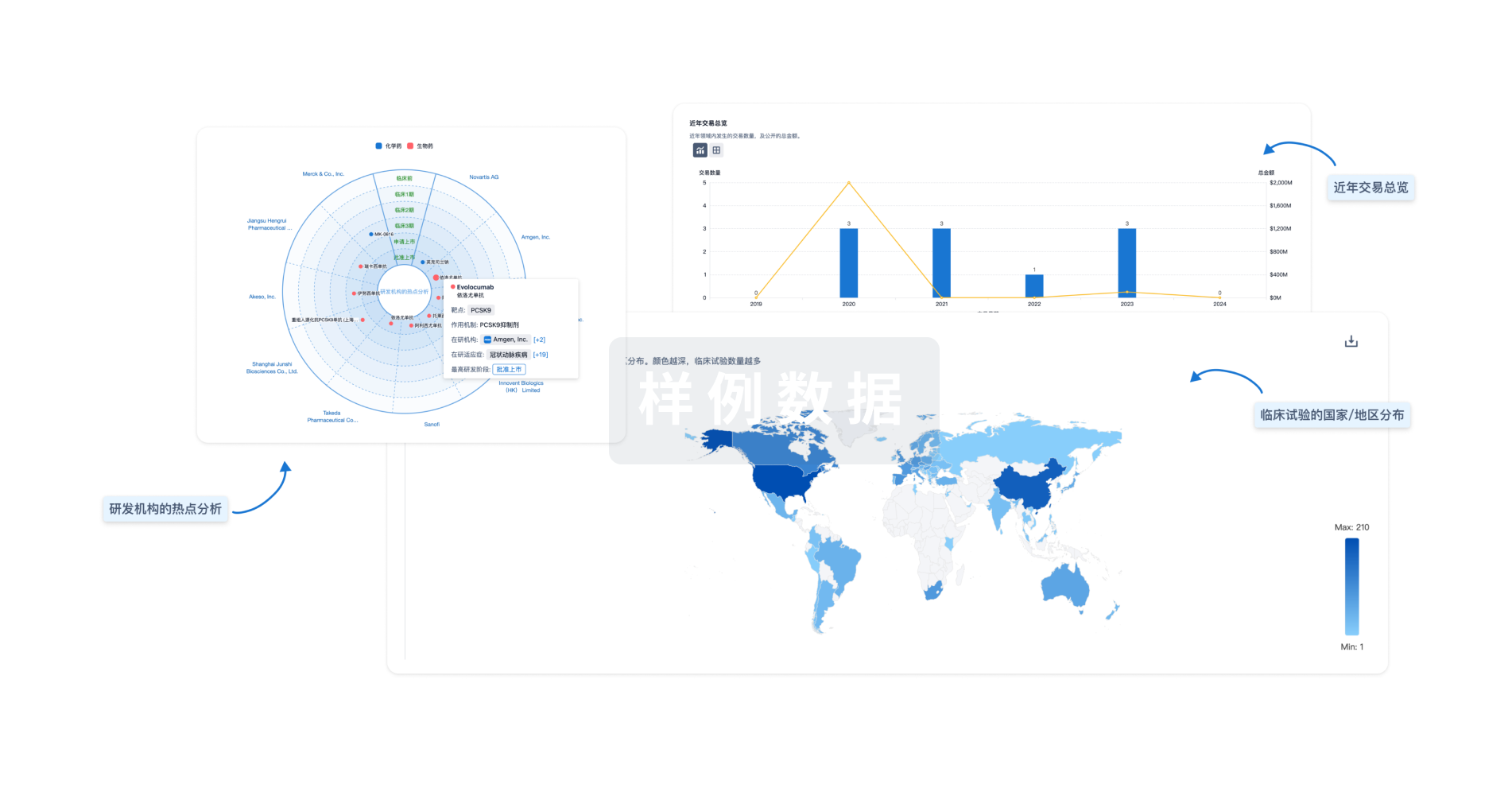预约演示
更新于:2025-05-07
OTUB1
更新于:2025-05-07
基本信息
别名 Deubiquitinating enzyme OTUB1、FLJ20113、FLJ40710 + [9] |
简介 Hydrolase that can specifically remove 'Lys-48'-linked conjugated ubiquitin from proteins and plays an important regulatory role at the level of protein turnover by preventing degradation (PubMed:12401499, PubMed:12704427, PubMed:14661020, PubMed:23827681). Regulator of T-cell anergy, a phenomenon that occurs when T-cells are rendered unresponsive to antigen rechallenge and no longer respond to their cognate antigen (PubMed:14661020). Acts via its interaction with RNF128/GRAIL, a crucial inductor of CD4 T-cell anergy (PubMed:14661020). Isoform 1 destabilizes RNF128, leading to prevent anergy (PubMed:14661020). In contrast, isoform 2 stabilizes RNF128 and promotes anergy (PubMed:14661020). Surprisingly, it regulates RNF128-mediated ubiquitination, but does not deubiquitinate polyubiquitinated RNF128 (PubMed:14661020). Deubiquitinates estrogen receptor alpha (ESR1) (PubMed:19383985). Mediates deubiquitination of 'Lys-48'-linked polyubiquitin chains, but not 'Lys-63'-linked polyubiquitin chains (PubMed:18954305, PubMed:19211026, PubMed:23827681). Not able to cleave di-ubiquitin (PubMed:18954305, PubMed:23827681). Also capable of removing NEDD8 from NEDD8 conjugates, but with a much lower preference compared to 'Lys-48'-linked ubiquitin (PubMed:18954305, PubMed:23827681).
Plays a key non-catalytic role in DNA repair regulation by inhibiting activity of RNF168, an E3 ubiquitin-protein ligase that promotes accumulation of 'Lys-63'-linked histone H2A and H2AX at DNA damage sites (PubMed:20725033, PubMed:22325355). Inhibits RNF168 independently of ubiquitin thioesterase activity by binding and inhibiting UBE2N/UBC13, the E2 partner of RNF168, thereby limiting spreading of 'Lys-63'-linked histone H2A and H2AX marks (PubMed:20725033, PubMed:22325355). Inhibition occurs by binding to free ubiquitin: free ubiquitin acts as an allosteric regulator that increases affinity for UBE2N/UBC13 and disrupts interaction with UBE2V1 (PubMed:20725033, PubMed:22325355). The OTUB1-UBE2N/UBC13-free ubiquitin complex adopts a configuration that mimics a cleaved 'Lys48'-linked di-ubiquitin chain (PubMed:20725033, PubMed:22325355). Acts as a regulator of mTORC1 and mTORC2 complexes (PubMed:29382726, PubMed:35927303). When phosphorylated at Tyr-26, acts as an activator of the mTORC1 complex by mediating deubiquitination of RPTOR via a non-catalytic process: acts by binding and inhibiting the activity of the ubiquitin-conjugating enzyme E2 (UBE2D1/UBCH5A, UBE2W/UBC16 and UBE2N/UBC13), thereby preventing ubiquitination of RPTOR (PubMed:35927303). Can also act as an inhibitor of the mTORC1 and mTORC2 complexes in response to amino acids by mediating non-catalytic deubiquitination of DEPTOR (PubMed:29382726). |
关联
4
项与 OTUB1 相关的药物靶点 |
作用机制 OTUB1抑制剂 |
在研适应症 |
非在研适应症- |
最高研发阶段临床前 |
首次获批国家/地区- |
首次获批日期1800-01-20 |
作用机制 OTUB1抑制剂 [+1] |
在研机构 |
原研机构 |
在研适应症 |
非在研适应症- |
最高研发阶段药物发现 |
首次获批国家/地区- |
首次获批日期1800-01-20 |
100 项与 OTUB1 相关的临床结果
登录后查看更多信息
100 项与 OTUB1 相关的转化医学
登录后查看更多信息
0 项与 OTUB1 相关的专利(医药)
登录后查看更多信息
272
项与 OTUB1 相关的文献(医药)2025-07-01·Cellular Signalling
OTUB1 promotes glioma progression by stabilizing TRAF4
Article
作者: Liu, Hongjun ; Qi, Jian ; Tang, Xiaoping ; Li, Zhou ; Tan, Shasha ; Zhang, Junhao
2025-07-01·Cellular Signalling
OTUB1 promotes the progression of acute myeloid leukemia by regulating glycolysis via deubiquitinating c-Myc
Article
作者: Zhang, Ying ; Zhang, Hongyan ; Wang, Meng ; Deng, Ying ; Liao, Yang ; Wan, Peng ; Zhao, Yi ; Liu, Beizhong ; Zhong, Liang
2025-06-01·Journal of Stroke and Cerebrovascular Diseases
FTO-mediated m6A Demethylation of OTUB1 stabilizes SLC7A11 to alleviate Ferroptosis in cerebral ischemia/reperfusion injury
Article
作者: Qi, Xiaokun ; He, Jianwen ; Liu, Wentao ; Zhou, Zonghua ; Shen, Youjin
9
项与 OTUB1 相关的新闻(医药)2025-04-13
前言AIDD Pro 根据国内外各大网站以及人工智能药物设计主流新闻网站及公众号,从 AIDD会议、AIDD招聘,重大科研进展、行业动态、最新报告发布等角度,分析挖掘了每周人工智能辅助药物设计领域所发生的、对领域技术发展产生重大推动作用的事件,旨在帮助 AIDD领域研究人员和业内人士及时追踪最新科研动态、洞察前沿热点。如果您觉得符合以上要求的内容我们有遗漏或者更好建议,欢迎后台留言。科研进展2025年4月11日【靶向嵌合体】J. Am. Chem. Soc. | 基于USP28的去泛素酶靶向嵌合体用于癌症治疗2025年4月11日【药物相互作用】ACS Bio Med Chem Au | 药物相互作用中熵和疏水效应的问题归因2025年4月10日【靶点】ACS Med. Chem. Lett. | 药物靶点的遗传变异:我们准备好进入精准药物化学时代了吗?2025年4月10日【药物发现】J. Chem. Inf. Model. | 比较MMPDB和REINVENT4生成的分子与药物发现设计团队的想法2025年4月9日【蛋白质-配体】J. Chem. Theory Comput. | 基于量子力学的最小挖掘算法计算蛋白质-配体结合自由能2025年4月9日【QSAR】J. Chem. Inf. Model. | PoseidonQ:一个免费的机器学习平台,用于开发、分析和验证用于药物发现的高效和便携式QSAR模型具体信息,请滑动下方文字1.【靶向嵌合体】去泛素酶靶向嵌合体(DUBTACs)是一类新兴的治疗方法,它可以通过劫持去泛素酶(DUB)来稳定肿瘤抑制因子,从而提供了从传统方法到靶向肿瘤抑制因子的战略支点。然而,迄今为止,只有OTUB1和USP7被用于DUBTAC的开发。在这里,我们首次展示了USP28可以用于开发dubtac。利用USP28非共价配体,我们制作了USP28-招募dubtac,有效地稳定了ΔF508-CFTR突变蛋白,其效果与先前报道的OTUB1-和usp7 -招募CFTR dubtac相当。此外,我们开发了usp28募集cGAS dubtac,有效稳定了cGAS,提高了cGAS- sting信号通路,并引发了抗增殖作用。我们还开发了一流的靶向癌症代谢途径的PPARγ dubtac。我们的先导PPARγ DUBTACs有效稳定PPARγ并抑制癌细胞增殖,从而提供了一种新的潜在的抗癌治疗方法。因此,本研究进一步推进了靶向蛋白稳定领域的研究。链接网址:https://pubs.acs.org/doi/10.1021/jacs.5c01889DOI:https://doi.org/10.1021/jacs.5c018892.【药物相互作用】ΔG药物与生物聚合物的亲和性及其非共价相互作用在药物发现中起着至关重要的作用。可以设计超分子复合物来鉴定和定量特定的相互作用,包括它们对介质的依赖;它们还保证了ΔΔG增量的可加性。这样的分析有助于澄清分子间缔合中的疏水效应,这种效应在小烷基中几乎无法测量,但在弯曲表面中,配体取代缺乏氢键的水分子会导致相当大的焓增益。很难预测熵贡献TΔS到ΔG在5%到90%以上之间变化,特别是在药物关联中,从文献数据中可以明显看出。正如几种药物复合物所说明的那样,许多所谓的疏水效应实际上涉及范德华作用或色散相互作用。超分子卟啉复合物的测量使我们能够得出许多基团的分散结合贡献,这与极化率有关。因此,杂原子或π系总是导致van der Waals贡献的增强,而对于疏水效应则相反。超分子复合物的结合贡献在未来也可以帮助人工智能方法在药物发现中,通过扩展含有具有期望结合贡献基团的潜在配体的混合数据库。链接网址:https://pubs.acs.org/doi/10.1021/acsbiomedchemau.4c00148DOI:https://doi.org/10.1021/acsbiomedchemau.4c001483.【靶点】自然遗传变异深刻地影响药物靶标相互作用,导致体外生物学数据的变化。总体发生或“罕见遗传变异”在人群群体中是普遍和丰富的。将人群水平的遗传信息更早地纳入药物发现管道,将使药物化学家能够为精准医学运动做出贡献,设计出与人群更相关的药物。链接网址:https://pubs.acs.org/doi/10.1021/acsmedchemlett.5c00153DOI:https://doi.org/10.1021/acsmedchemlett.5c001534.【药物发现】这项研究比较了由Sanders三机构治疗发现研究所的药物发现项目团队设计的分子与由两种计算工具(MMPDB和REINVENT4)生成的分子。研究了七个不同化学型的不同测试案例,以探索这些计算工具在药物发现早期阶段补充人类专业知识的潜力。通过比较MMPDB和REINVENT4生成的分子结构和性质与项目设计团队设计的分子结构和性质,我们旨在评估这些工具的价值。结果表明,MMPDB和REINVENT4覆盖的化学空间比药物发现项目组的想法覆盖的区域大。然而,这两种方法覆盖的化学空间有很大的不同,两种方法都不能完全覆盖药物发现项目组确定的化学空间。因此,计算方法相互补充,并与药物发现项目组的想法相辅相成。生成分子设计工具的有效应用有可能通过扩大药物发现过程中探索的化学空间和实现最佳探索来加速新治疗候选药物的识别。链接网址:https://pubs.acs.org/doi/10.1021/acs.jcim.5c00250DOI:https://doi.org/10.1021/acs.jcim.5c002505.【蛋白质-配体】提出了一种结合挖掘极小值(基于统计力学端点的方法)和量子力学势计算蛋白质-配体结合自由能的新方法——蛋白质-配体QM-VM2 (PLQM-VM2)。PLQM-VM2是根据一个高度灵活的工作流来描述的,该工作流是从蛋白质数据库(PDB)文件和包含二维(2D)或三维(3D)配体系列坐标的化学结构数据文件(SD文件)发起的。该工作流程利用先前开发的第二代最小挖掘方法MM- vm2的分子力学(MM)实现,提供蛋白质、自由配体和蛋白质配体构象的集合,并通过量子化学软件包GAMESS在QM理论的选定水平上进行后处理,以纠正基于MM的构象几何形状和电子能量。修正后的能量用于计算构型积分,通过对构象系综的求和得到修正后的化学势,最终得到修正后的束缚自由能。在这项工作中,PLQM-VM2应用于三个基准蛋白配体系列:HIV-1蛋白酶/38配体,c-Met/24配体和TNKS2/27配体。QM修正在理论的半经验三阶密度泛函紧密结合水平上进行,并辅以色散和阻尼修正(DFTB3-D3(BJ)H)。用类导体极化连续体模型(PCM)解释了体溶剂化效应。DFTB3-D3(BJ)H/PCM单点能量和几何优化QM校正结合两种不同的模型进行,解决了与蛋白质大小的分子系统相关的大规模计算缩放问题。一种是蛋白质切割模型,在结合位点内和周围的一组蛋白质原子被切割出来,悬垂的键被氢覆盖,只有直接在蛋白质结合位点上的原子才能随着配体原子移动。另一种模型是片段分子轨道(Fragment Molecular Orbital, FMO)方法,它包括整个蛋白质系统,但同样只允许结合位点和配体原子移动。与MM-VM2相比,QM校正的所有四种方法在等级顺序和与实验确定的结合亲和力的参数线性相关性方面都有显著改善。总体而言,具有几何优化的FMO表现最好,但更便宜的切割单点能量方法仍然提供了良好的精度。此外,一个明确的结果是,与使用MM-VM2计算的结果相比,PLQM-VM2计算的三种不同测试系统的结合自由能在能量尺度上具有直接可比性。这为未来开发基于plqm - vm2的多蛋白筛选能力来检查配体系列的脱靶活性提供了基础。PLQM-VM2在单个计算节点(32个CPU内核)上计算蛋白质-配体复合物化学势的基准时间范围从单点能量方法的约30-45分钟到几何优化的切出方法的约5小时,以及几何优化的全蛋白质FMO方法的约35小时。链接网址:https://pubs.acs.org/doi/10.1021/acs.jctc.4c01707DOI:https://doi.org/10.1021/acs.jctc.4c017076.【QSAR】强大的机器学习算法的出现以及大量药理学数据的可用性为QSAR提供了新的燃料,为获得高度预测模型提供了前所未有的选择,以协助新的生物活性化合物的基本原理设计,筛选和优先考虑大型分子文库,以及将新药重新用于新的临床用途。本文介绍了PoseidonQ (Personal Optimization Software for Efficient Implementation and Derivation of Online QSAR的首字母缩写),这是一个用户友好的软件解决方案,旨在简化用于药物设计和发现的QSAR模型的推导。PoseidonQ结合了22种机器学习算法,17种类型的分子指纹和208个RDKit分子描述符,并能够快速推导回归和分类模型,以及计算和易于解释的适用性域。重要的是,该平台自动链接到ChEMBL数据库的最新版本,从而提供了对大量精心整理的生物活性数据的简化访问。重要的是,用户还可以根据可定制的过滤设置收集高质量的实验数据。值得注意的是,PoseidonQ通过与Streamlit Cloud和GitHub的无缝集成,促进了训练有素的QSAR模型作为基于web的应用程序的部署,使用户能够毫不费力地共享、改进和集成模型。有趣的是,将QSAR模型转换为基于web的应用程序使它们可以免费访问,可移植,并且可以无限制地筛选大量新数据。通过将数据准备、模型生成和部署统一到一个直观的工作流程中,PoseidonQ为广泛的研究人员提供了先进的药物设计和发现的QSAR建模,无论他们的技能水平如何。PoseidonQ在复杂的机器学习技术和实际药物发现应用之间架起了桥梁,提高了现代药物发现项目中QSAR方法的效率、协作和采用。PoseidonQ适用于Windows和Linux (ubuntu 22.04发行版)操作系统,可以从https://github.com/Muzatheking12/PoseidonQ免费下载。链接网址:https://pubs.acs.org/doi/10.1021/acs.jcim.4c02372DOI:https://doi.org/10.1021/acs.jcim.4c02372上下滚动查看更多药企动态2025年4月11日【睿健医药】睿健医药完成近亿元B+轮融资2025年4月11日【士泽生物】中美双报双批!士泽生物帕金森病细胞治疗新药获国家药监局批准注册临床试验2025年4月10日【百奥泰】百奥泰FRα ADC启动III期临床2025年4月10日【信念医药】仅需一次给药!国内首款 AAV 基因治疗新药获批上市,治疗血友病2025年4月9日【武田】武田创新疗法在中国申报上市,开创治疗cTTP的新篇章2025年4月9日【先声药业】先声药业 FGFR2b ADC 国内首次获批临床各动态具体信息,请滑动下方文字1.【睿健医药】4月11日,聚焦iPSC化学诱导平台的睿健医药宣布完成近亿元B+轮融资。本轮融资由丰川资本领投,荷塘创投跟投,易凯资本担任独家财务顾问。叠加公司去年10月完成的超亿元B轮融资,睿健医药已在不到半年时间内累计融资超2亿元人民币,创下中国iPSC领域融资额新高。链接网址请戳我2.【士泽生物】2025年4月11日世界帕金森病日,士泽生物医药(苏州)有限公司(江苏省双创领军团队及姑苏重大创新团队;Roche Accelerator Member)宣布开发的异体通用“现货型”iPSC衍生多巴胺能神经前体细胞注射液(“XS411注射液”)的新药注册临床试验申请,已正式获我国国家药品监督管理局(NMPA)一次性无发补完全批准,用于治疗全球第二大神经退行性疾病帕金森病。链接网址请戳我3.【百奥泰】4月10日,药物临床试验登记与信息公示平台显示,百奥泰启动了BAT8006的首个III期临床。该药物是继普方生物的PRO1184(rinatabart sesutecan)后,第二款进入III期阶段的国产FRα ADC,也是百奥泰第二个启动III期临床的ADC药物。链接网址请戳我4.【信念医药】4 月 10 日,NMPA 官网显示,信念医药的 1 类新药波哌达可基注射液(商品名:信玖凝,研发代号:BBM-H901)获批上市,用于治疗血友病 B(先天性凝血因子Ⅸ缺乏症)成年患者。这是国内首个获批上市的 AAV 基因治疗药物,也是首个针对罕见病的基因治疗药物,曾先后被 NMPA 纳入突破性疗法和优先审评通道。链接网址请戳我5.【武田】4月9日,CDE官网公示,武田(Takeda)申报的注射用阿帕达酶α(Adzynma)上市申请已获得受理。这款创新的酶替代疗法用于治疗先天性血栓性血小板减少性紫癜(cTTP),已于2023年11月获得美国FDA批准,并成为首款获得FDA批准的cTTP治疗酶替代疗法,适用于成人和儿童患者。链接网址请戳我6.【先声药业】4 月 9 日,CDE 官网显示,先声药业注射用 SIM0686 获批临床,用于治疗 FGFR2b 阳性的局部晚期/转移性实体瘤。SIM0686 是先声药业自主开发的一款靶向 FGFR2b(成纤维细胞生长因子受体 2b)的 ADC 产品。临床前研究数据显示,SIM0686 具有显著的抗肿瘤疗效,有望作为单药或与 SoC 联合为 FGFR2b 过表达实体瘤患者提供新的治疗选择。链接网址请戳我上下滚动查看更多会议信息2025年4月17-18日 商图举办IGC 2025 第九届免疫基因及细胞治疗大会2025年4月25-30日 美国癌症协会举办2025美国癌症协会年会(AACR)2025年5月22-23日 举办I-RNA 2025第五届小核酸药物产业深度聚焦峰会2025年6月12-13日 智药邦举办2025人工智能与生物医药生态大会2025年6月27-28日 美国华人生物医药科技协会中国分会(CBA-China)主办,苏州云程万川(盛杰)承办2025美国华人生物医药科技协会CBA-China中国年会各会议具体详情和参会方式,请滑动下方文字IGC 2025 第九届免疫基因及细胞治疗大会主办方:商图会议时间:2025年4月17-18日会议地点:北京会议主旨:深度解析免疫细胞治疗、干细胞与外泌体治疗、基因编辑及基因治疗、mRNA疫苗及药物、人用与兽用疫苗、免疫治疗抗体及联合治疗等领域的技术挑战与热点,促进国内产学研医的深入交流与合作。链接网址请戳我2025美国癌症协会年会(AACR)主办方:美国癌症协会会议时间:2025年4月25-30日会议地点:芝加哥会议主旨:美国癌症协会年会是世界上历史最悠久、最大的科学会议,它关注于高质量癌症研究高及创新的各个方面。其科学的广度和卓越的声誉吸引了该领域首屈一指的研究人员,该协会的设计和服务促进了癌症领域科学家在知识和观点上的交流,他们致力于癌症研究、为下一届癌症研究人员提供培训的机会、提高公众对癌症的了解。链接网址请戳我I-RNA 2025第五届小核酸药物产业深度聚焦峰会会议时间:2025年5月22-23日会议地点:南京会议主旨:聚焦小核酸药物的治疗潜力与技术创新,深入探讨研发难题、递送技术突破及临床转化路径,全面解读市场趋势与未来机遇,推动小核酸药物领域持续突破,共同助力行业高质量发展!链接网址请戳我2025人工智能与生物医药生态大会主办方:智药邦会议时间:2025年6月12-13日会议地点:上海会议主旨:大会将广泛邀请国内外顶尖学术界和企业界知名专家学者,共同探讨AI赋能生物医药领域的前沿进展、重要案例、关键问题和各方思考。大会旨在为各方提供一个高水平的信息沟通平台,加强交流与合作,加速生物制药相关技术和产业的发展。链接网址请戳我2025美国华人生物医药科技协会CBA-China中国年会主办方:美国华人生物医药科技协会中国分会会议时间:2025年6月27-28日会议地点:苏州会议主旨:立足国际视野及产业高度,以创新为引领,围绕全球最新监管动态、新技术/AI革新及成果转化、先进治疗技术、药物创新开发、全球药物开发策略、新兴市场出海布局等前沿热门话题,共同探索前沿技术创新与全球医药合作,促进新质生产力培育及未来产业发展,推动全球健康事业新发展。链接网址请戳我上下滚动查看更多版权信息本文内容均由小编收集于公开的各个网络平台,发布的目的仅为了方便大家一站式了解AIDD行业信息,并未对发布源头进行真实性验证。如您发现相关信息有任何版权侵扰或者信息错误,请及时联系AIDD Pro(请添加微信号18515220072)进行删改处理。原创内容未经授权,禁止转载至其他平台。有问题可发邮件至yangzhuoqi@stonewise.cn关注我,更多资讯早知道↓↓↓
临床2期
2025-01-17
·小药说药
关注小药说药,一起成长!
前言
基于T细胞的免疫疗法的出现显著改变了癌症患者的治疗模式。尽管取得了成功,但目前批准的免疫治疗方案仍然存在局限性。因此,需要对T细胞活化和抑制的分子机制有更深入的了解,以合理地扩大改善免疫治疗的靶点和可能性。
免疫信号通路下游的蛋白质泛素化对于几乎所有免疫反应,特别是T细胞激活的正调节和负调节至关重要。大量研究表明,泛素化通过控制蛋白质的功能、定位和稳定性发挥多种细胞和分子作用,对泛素依赖性通路的调节可以显著改变T细胞的活化并增强抗肿瘤反应。因此,人们正在积极开发有选择性地利用泛素相关酶用于癌症治疗的技术,靶向泛素化为推进T细胞免疫治疗提供了巨大的可能性。
蛋白质泛素化
泛素化是一种翻译后修饰,泛素是一种由76个氨基酸组成的小蛋白质,通常由一条泛素链与底物蛋白质内的赖氨酸残基共价连接。泛素化通过各种方式影响蛋白质功能,例如通过影响蛋白质稳定性、周转率、细胞定位,以及诱导影响与其他蛋白质相互作用的构象变化。
该过程由E1泛素激活酶启动,该酶使用ATP激活,然后将泛素单体转移到E2泛素结合酶。泛素最终在E3泛素连接酶的作用下从E2转移到底物。
泛素化是多方面的,底物蛋白可以仅用一个泛素(单泛素化)、多个单泛素(多个单泛素化)或多泛素链(多泛素化)标记。由于泛素本身有七个赖氨酸(Lys6、Lys11、Lys27、Lys29、Lys33、Lys48和Lys63)和一个N端甲硫氨酸残基(M1),可以进行泛素化,因此可以形成几种结构不同的同质/同型、混合/异型和分支多泛素链。
泛素化除了是通过蛋白质体降解蛋白质的主要调节器外,实际上是几乎所有细胞信号级联的多功能调节器。泛素化蛋白质的命运取决于添加的泛素数量和形成泛素连接的泛素氨基酸。通过这种方式,并且由于拓扑结构不同链的多种可能性,泛素构成了一种高度通用的信号。
单泛素化和多泛素化参与膜受体的内吞作用,以及蛋白质降解、定位和蛋白质-蛋白质相互作用,这些类型的链也与TGF-β信号传导有关。在同型多泛素链中, Lys48和Lys63连接的链是最丰富,它们分别驱动蛋白酶体降解和调节多种细胞信号事件。Lys11连接链调节细胞周期和线粒体自噬,M1连接链对炎症固有反应至关重要,特别是调节NF-κB信号。
由Lys6-、Lys27-、Lys29-、Lys33泛素连接链调节的细胞过程仍然不太清楚。Lys27连接链似乎对调节先天免疫、细胞周期和线粒体功能非常重要。Lys6链似乎参与DNA修复和线粒体自噬,而Lys29链与Wnt信号以及蛋白毒性应激和细胞周期相关。Lys33链在高尔基体后转运和T细胞受体(TCR)调节中起着关键作用。
此外,非常重要的是,泛素在底物上的组装可以通过去泛素化酶(DUB)的作用逆转,去泛素化酶水解并从底物上去除泛素,使泛素化成为一种瞬时修饰,DUB对于维持生理性泛素平衡是必不可少的。这种平衡的失调与人类疾病的发病机制有关,特别是癌症、感染、神经退行性变和免疫紊乱,因此,DUB已开始作为基于抑制剂的治疗成为有吸引力的药物靶点。
TCR/CD3激活中的泛素途径
E3连接酶
E3泛素连接酶Casitas B系淋巴瘤(Cbl-B)是最具特征的E3连接酶,是T细胞活化的主要参与者。在T细胞激活时,它在免疫突触处被招募到TCR中,在TCR下游发挥多种抑制机制。
Cbl-b通过其多个蛋白质相互作用结构域与关键TCR信号体分子(如LCK、SLP76、ZAP70、Vav1、PKCθ和PI3K)相互作用。Cbl-b与E3连接酶Itch协同作用,能够介导TCR-ζ的Lys33连接的多泛素化,其不针对TCR受体进行降解或内吞,而是阻止其磷酸化并进一步与下游ZAP70激酶结合。通过这些相互作用,以及一些信号体成分的泛素化,Cbl-b强烈抑制T细胞活化。Cbl-b敲除小鼠具有过度活跃的T细胞,其激活不需要CD28,此外,Cbl-b基因敲除小鼠中从未描述过自身免疫损伤。因此,Cbl-b具有多个检查点抑制作用和极小的自身免疫毒性,是未来靶向癌症免疫治疗的有力候选。
与淋巴细胞无能相关的基因(GRAIL)是一种跨膜E3连接酶,定位于内体,也对T细胞活化起负调节作用。TCR介导的T细胞活化促进GRAIL的表达,而GRAIL反过来又阻碍T细胞活化。机制上,GRAIL通过非降解泛素链稳定和激活Rho-鸟嘌呤解离抑制剂(RhoGDI),导致细胞骨架重排和IL-2分泌缺陷。
NRDP1是另一种损害TCR信号的E3连接酶。T细胞激活后,NRDP1将Lys33多聚泛素非降解链添加到ZAP70激酶。Lys33连接的泛素链有助于招募Sts1和Sts2磷酸酶,最终使ZAP70去磷酸化和失活。
除了作用于近端信号体外,E3连接酶还通过进一步作用于下游抑制T细胞活化,控制导致T细胞活化转录因子核易位的关键转导事件。例如,在TCR/CD28连接后,E3连接酶Pellino1(PELI1)通过用Lys48多泛素链标记c-Rel来阻止NF-κB通路,导致其蛋白酶体降解。
DUBs
去泛素化酶A20和CYLD,在调节天然免疫细胞中的NF-κB信号中具有重要作用,也能显著改变T细胞功能。外周T细胞中A20的条件性缺失导致CD8+T细胞具有增强的NF-κB信号,即使在低抗原剂量下也能更有效地被激活,以产生更高水平的IL-2和IFN-γ。
CYLD可以通过NF-κB损害T细胞活化,它是通过将CBM复合物下游TAK1激酶的Lys63泛素链进行去泛素化。CYLD缺陷小鼠出现结肠炎,T细胞频率和活化增加。
使用类似的作用机制,去泛素酶USP18对TAK1的去泛素化抑制TCR。USP18的基因缺失导致T细胞中NF-κB和NFAT的过度激活和IL-2的过度产生。相反,去泛素酶USP9X和USP12通过从BCL10中去除抑制性泛素链来积极调节NF-κB通路,从而阻断CBM信号复合物的组装。因此,缺乏USP9X或USP12的T细胞在TCR激活时表现出较低水平的NF-κB激活,以及增殖和细胞因子生成减少。
TCR内化
TCR信号幅度和持续时间由细胞膜受体的内化、再循环和降解的平衡决定。在抗原刺激下,TCR/CD3复合物是泛素化的,而泛素化对于表面受体的内化至关重要。据报道,Cbl-b可单独或与E3连接酶c-Cbl联合促进TCR的内化,Cbl-b还干扰激活和聚集,从而破坏免疫突触的稳定性,进一步减弱TCR信号。
类似地,E3连接酶GRAIL可以通过蛋白酶体多泛素化和降解CD3ζ分子来下调表面TCR/CD3复合物的表达。最近的研究表明,用于CAR-T治疗的CAR受体的表面表达也受到泛素介导的内吞和降解的影响。注入患者体内的CAR-T细胞持续性差是这种肿瘤免疫疗法的主要限制。最近的一项研究能够通过对细胞质结构域的所有赖氨酸残基进行突变来提高CAR的稳定性,这有效地绕过了CARs的泛素化依赖性溶酶体降解,因此,这些CAR-T细胞改善了CAR的持久性和来自内体的信号传导,同时增强了效应器功能,从而在小鼠模型中产生持久的抗肿瘤免疫反应。
共刺激受体下游的泛素途径
CD28
E3连接酶Cbl-b是CD28介导的信号传导的主要抑制剂,从机制上讲,E3连接酶Cbl-b通过结合和泛素化PI3K的p85β亚单位来抑制CD28依赖的PI3K途径。
E3连接酶不仅能阻碍CD28信号传导,而且能促进CD28信号传导。例如,TCR/CD28激活NFAT涉及E3连接酶TRAF6。TRAF6被招募到免疫突触与支架蛋白LAT相互作用,并通过Lys63泛素化增强LAT磷酸化和TCR信号。
为了充分激活T细胞,CD28共受体必须克服Cbl-b抑制。CD28信号通过触发Cbl-b的翻译后修饰来阻断Cbl-b抑制途径,最终导致其蛋白酶体降解。其中E3连接酶NEDD4发挥着重要作用,据报道NEDD4在CD28共刺激下结合并泛素化Cbl-b进行蛋白酶体降解。
其他共刺激受体
与CD28类似,肿瘤坏死因子受体(TNFR)家族成员的共刺激受体4-1BB、CD40L、OX40和GITR与TCR协同促进T细胞活化,尤其是增殖和细胞因子的产生。作为TNFRs,它们缺乏内在的酶功能,依赖于几种E3连接酶,包括TRAF(TRAF1/2/3)、cIAP1/2和LUBAC,在导致NF-κB活化的信号转导级联中引导大量Lys63、Lys48和线性泛素化事件。去泛素酶A20、CYLD和OTULIN可以清除这些泛素化事件以阻止NF-κB的活化。
抑制性受体下游泛素途径
CTLA-4
到目前为止,没有任何E3直接泛素化CTLA-4的报道,也没有CTLA-4中泛素化位点的记录。然而,CTLA-4缺陷型T细胞的泛素修饰总体上显著减少,这有力地表明了泛素化事件在CTLA-4途径中的重要性。此外,实验证据表明,主要CTLA-4抑制功能由关键的T细胞抑制性E3连接酶介导,该连接酶也调节T细胞活化,即Cbl-b、ITCH和GRAIL。
此外,Cbl-b、ITCH和GRAIL是T细胞无能的基本驱动因素,而且这三种E3连接酶还通过调节Treg的发育和功能发挥重要的免疫抑制作用。Cbl-b和ITCH参与TGF-β介导的Foxp3调节,缺乏这两种E3连接酶都会损害TGF-β诱导的Foxp3+Tregs(iTreg)的发育,导致iTreg低表达,功能缺陷。
PD-1
与CTLA-4不同,一些报告强调了泛素化在PD-1/PD-L1系统中的关键作用。对于T细胞上的PD-1受体,Cbl-b也作为PD-1抑制途径的关键介质显著参与,缺乏Cbl-b的T细胞对PD-1抑制具有抵抗力。没有Cbl-b,PD-1在抑制IFN-γ产生或诱导T细胞活化后的细胞死亡方面效率低下。
另一种Cbl E3连接酶c-Cbl也影响PD-1,但与Cbl-b相反,它是一种负性调节因子。c-Cbl与PD-1的胞质尾部结合,并作为E3连接酶,泛素化PD-1进行蛋白酶体降解。因此,c-Cbl减少提高了CD8+T细胞和巨噬细胞中PD-1的表达。
同样,E3连接酶FBXO38通过介导PD-1降解来控制T细胞抗肿瘤反应。从机理上讲,FBXO38通过在Lys233处添加Lys48多聚泛素链来标记PD-1进行降解。缺乏FBXO38的黑色素瘤和结直肠癌小鼠模型具有更高的肿瘤负荷,这与肿瘤浸润性T细胞中PD-1的高表达有关。
PD-L1
PD-L1的肿瘤水平是肿瘤免疫的重要决定因素。几项研究已确定癌细胞利用EGFR信号稳定PD-L1表达以逃避T细胞免疫。E3连接酶识别并泛素标记PD-L1进行蛋白水解,主要依赖于糖原合成酶激酶3(GSK3α/β)。GSK3β磷酸化PD-L1的C端结构域,以招募E3连接酶β-TrCP用于PD-L1泛素依赖性降解。而EGFR信号通过诱导GSK3β磷酸化位点附近的PD-L1大量糖基化来对抗GSK3β/β-TrCP/PD-L1降解途径。
另一项研究进一步表明GSK3α/ARIH1是另一种诱导PD-L1蛋白水解的激酶/E3连接酶对。E3连接酶ARIH1识别S279/S283处PD-L1的GSK3α依赖性磷酸化,随后PD-L1 Lys48泛素化和降解。最近,还发现EGFR通过额外干扰膜结合MARCH8 E3连接酶增加PD-L1水平,该连接酶也以PD-L1为降解靶点。最后,c-Cbl过表达,单独或与Cbl-b联合,也可以降低STAT3/AKT/ERK磷酸化,从而下调PD-L1表达并增加抗肿瘤反应。
Cullin3 SPOP和TRIM21E3连接酶通过泛素化依赖性降解进一步破坏PD-L1的稳定性,它们的作用再次依赖于激酶,特别是细胞周期蛋白依赖性激酶CDK4和CDK5。然而,CDK4通过稳定Cullin3 SPOP协助PD-L1降解,而CDK5则消极干扰TRIM21对PD-L1的作用。
此外,PD-L1也因其他几种去泛素化酶而稳定,即OTUB1、USP9X、USP7。这些研究具有潜在的治疗意义,因为它们证明,抑制或清除这些DUB中的任何一种都可以重新激发小鼠的抗肿瘤反应,并使癌细胞对T细胞杀伤敏感。
泛素依赖途径肿瘤药物的开发
到目前为止,针对泛素依赖的途径主要是基于小分子抑制剂,这些小分子可以通过直接结合或变构作用阻断泛素相关酶的催化结构域,或阻止其与底物或其他调节蛋白结合。目前,已经开发了200多种化合物,其中许多化合物正在进行癌症治疗的临床前和临床试验。
大多数基于泛素的小分子化合物被设计成靶向癌细胞中必需的泛素途径。随着以T细胞为基础的肿瘤免疫治疗的出现,针对选择性E3和DUB的靶向抑制已有研究,其中关键的细胞内检查点T细胞抑制剂Cbl-b具有巨大的潜力。已有研究利用RNA干扰成功地下调了T细胞中的Cbl-b水平,这在不同的过继性T细胞转移肿瘤模型中产生了出色的体外和临床前结果,并且癌症患者对其耐受性良好,目前已进入临床试验(NCT02166255和NCT03087591)。此外,针对IAPs、MDM2和USP7的小分子已经进行了临床前试验,并证明单独使用或联合使用时,至少部分增强体内抗肿瘤免疫。
调节癌细胞中PD-L1降解的泛素化依赖途径也正在进行测试。例如,一种竞争性棕榈酰化抑制剂(CPP-S1),以防止PD-L1棕榈酰化,进而促进PD-L1泛素介导的降解。控制PD-L1泛素化和降解的EGFR信号通路也通过不同的方式在体内被有效阻断,包括EGFR小分子抑制剂、铜螯合剂和靶向CSN5的小分子,都显著增强T细胞抗肿瘤反应。
基于邻近性的治疗方法,包括PROTAC或分子胶技术,也正在迅速发展,以针对几种特定肿瘤蛋白质的蛋白酶体降解,目前有十几项临床试验正在验证这些基于泛素化技术的治疗潜力。
小结
数据表明,调节几种泛素依赖性途径,特别是所涉及的泛素依赖性酶,可以释放强烈、持久和靶向的抗肿瘤反应。目前,泛素领域也取得了巨大进展,开发出了多种新技术和新方法,可以专门针对几乎所有泛素依赖的酶,或者利用它们针对感兴趣的底物蛋白,包括肿瘤蛋白。展望未来,相信这些重要的泛素依赖途径的调节很快将成为改善靶向肿瘤免疫治疗的可行替代方案。
参考文献:
1.Ubiquitination in T-Cell Activation andCheckpoint Inhibition: New Avenues for Targeted Cancer Immunotherapy. Int J MolSci. 2021 Oct; 22(19): 10800.
公众号内回复“疫苗篇”或扫描下方图片中的二维码免费下载《小药说药疫苗篇》的PDF格式电子书!
公众号已建立“小药说药专业交流群”微信行业交流群以及读者交流群,扫描下方小编二维码加入,入行业群请主动告知姓名、工作单位和职务。
免疫疗法细胞疗法
2024-07-12
·精准药物
来源:药渡
撰文:balabala 编辑:哦呼
靶向嵌合体蛋白水解(PROTAC)技术代表了药物发现领域的突破性发展,利用泛素蛋白酶体系统特异性降解与疾病相关的蛋白质,多项目已进入临床开发。但针对CF和某些癌症,需开发靶向蛋白稳定剂TPS以对抗异常蛋白降解。
拓展阅读:
瞄准靶蛋白降解:中国在PROTAC药物战略布局中的新动向
PROTAC设计中Linker特性的探索与创新
靶向“不可成药”靶点,浅析PROTAC、分子胶靶向蛋白降解与靶向蛋白稳定技术
推动PROTAC药物开发新纪元:扩展PROTAC的E3连接酶
靶向蛋白质稳定技术(targeted protein stabilization,TPS)是近年来生物医学领域一种新兴的技术,旨在通过特定的方法来稳定细胞内的蛋白质,从而影响其功能和行为。这种技术潜在应用广泛,从基础研究到新药开发都有重要价值。
去泛素化酶靶向嵌合体(deubiquitinase-targeting chimeras,DUBTACs)是近年来逐渐发展的一种靶向蛋白质稳定技术,DUBTACs一般由靶蛋白配体、去泛素化酶配体和Linker三部分组成,这样的结构设计使得DUBTAC分子可以同时结合靶蛋白和去泛素化酶,诱导靶蛋白和去泛素化酶靠近,去除靶蛋白上的泛素链,从而达到稳定以泛素化依赖方式降解的特定蛋白质的水平(图1)。
图1. DUBTAC平台
在这里,我们总结了近年来DUBTAC技术的研发进展,详细探讨了其在生物医药领域的应用前景和潜在挑战。
01
基于OUTB1的DUBTACs
在2022年初,加州大学伯克利分校的Daniel K. Nomura教授团队运用基于活性的蛋白质图谱分析(activity-based protein profiling, ABPP)对65种去泛素化酶的反应性半胱氨酸进行全局性分析。
研究结果发现,泛素化酶OTUB1的C23位点不参与酶活性的调控且具有较高的亲核性,是一个理想的配体结合位点。由于细胞中主要介导蛋白质降解的最丰富的泛素链是K48链,而OTUB1则是靶向移除K48链的去泛素化酶。
理论上,利用OTUB1去针对性地去除特定蛋白上的泛素链,防止以泛素化依赖方式被降解的特定蛋白质被蛋白酶体降解,是非常有效的。
图2. EN523结构
(1)ΔF508-CFTR-DUBTACs
Daniel K. Nomura教授团队基于上述发现筛选出了一个与OUTB1高亲和力结合的共价配体EN523(图2)。其中,EN523与OTUB1结合是通过EN523的丙烯酰胺部分与OTUB1变构半胱氨酸残基Cys23共价作用来实现的。他们通过体外实验证明EN523对OTUB1的酶活性没有显著影响。
随后,研究人员将筛选到的EN523与ΔF508-CFTR调节剂Lumacaftor连接起来所获得的异源双功能小分子NJH-2-057用于靶向CFTR突变体ΔF508-CFTR的稳定从而改善囊性纤维化。
实验结果表明,NJH-2-057可以有效稳定ΔF508-CFTR,而单独使用Lumacaftor的结果则与对照组差异不明显(图3)。这一结果为DUBTAC技术的发展提供了概念验证。
图3. NJH-2-057稳定CFTR
(2)WEE1-DUBTACs
Daniel K. Nomura教授团队随后将DUBTAC技术应用于提高抑癌基因WEE1的稳定性,WEE1是一种非恶性真核体细胞中的肿瘤抑制激酶,可磷酸化细胞周期蛋白依赖性激酶(CDK1)-细胞周期蛋白B1复合物,以抑制有丝分裂S期和G2期的细胞周期进展,并且必须下调其活性才能发生有丝分裂进展。WEE1在许多肿瘤中被降解以促进癌细胞增殖。稳定癌细胞中WEE1激酶的水平有望阻止肿瘤生长。
研究人员将EN523与一种临床WEE1抑制剂AZD1775通过烷基链linker或基于聚乙二醇的linker连接合成了靶向肿瘤抑制性激酶WEE1的DUBTAC。研究显示,DUBTAC能显著稳定肝癌细胞系中的WEE1,而EN523或AZD1775单独治疗对WEE1水平没有影响(图4)。
图4. WEE1 DUBTAC稳定WEE1
这进一步证明了DUBTAC技术用于TPS的普适性,此外,Daniel K. Nomura教授团队的研究也强调了使用化学蛋白质组学支持的共价配体发现平台的实用性。
(3)TF-DUBTACs
2022年6月份,来自美国哈佛医学院的Wenyi Wei教授团队在此前研究的基础上,使用EN523招募去泛化素酶OTUB1进一步开发了能够稳定抑癌转录因子(Transcription Factor,TF)的首个TF-DUBTAC药物平台,旨在通过稳定TF实现对肿瘤的治疗(图5)。
图5. TF-DUBTAC平台示意图
研究人员分别将FOXO3A、p53、IRF3三种转录因子的结合配体叠氮基修饰DNA寡核苷酸与BCN(bicyclononyne)修饰的去泛素化酶OUTB1的共价配体(DUBL-X-BCN 1-10)通过SPAAC反应连接起来,设计合成出了一系列靶向FOXO3A、p53、IRF3三种转录因子的DUBTAC分子(图6),紧接着,研究人员通过体外实验测定了细胞水平上化合物对靶蛋白的稳定作用,并筛选出有效的TF-TUBTAC分子,细胞水平活性测试研究表明,相应的TF-DUBTAC 以OUTB1依赖的方式分别稳定了细胞内的FOXO3A、p53、IRF3。
图6. TF-DUBTAC作用机理图示
这进一步说明了TF-DUBTAC是一个可推广的平台,可实现抑癌转录因子的选择稳定性,可作为抑制肿瘤生成的治疗手段。同时也表明DUBTAC技术在癌症治疗方面的普适性和有效性。
02
基于USP7的DUBTACs
由于基于去泛素化酶OTUB1共价配体开发出的DUBTACs可能与其他共价抑制剂类似存在毒性或超敏反应等劣势,因此,开发基于其他去泛素酶的可逆招募配体是TPS领域的重要发展方向。
2024年4月份,美国哈佛医学院的Wenyi Wei教授团队开发了第一个基于去泛素化酶USP7的DUBTAC,其利用USP7的非共价配体实现了选择性稳定CFTR和AMPK蛋白的目的(图7)。
图7.USP7-DUBTAC平台示意图
(1)ΔF508-CFTR-DUBTACs
首先,研究人员选择先前报道过的USP7 ligand #1作为去泛素化酶USP7的配体,通过分析配体与USP7复合物的共晶结构,选择配体分子USP7i-#4a结构中位于结合口袋外的氨基作为linker连接位点进行分子设计。
研究人员将USP7 ligand#1与ΔF508-CFTR调节剂Lumacaftor通过linker连接合成了一系列的靶向CFTR的DUBTAC的分子,并在细胞水平上测定化合物对CFTR蛋白的稳定作用(图8)。
图8.基于usp7的dubtac来稳定靶蛋白
研究结果表明,化合物MS6869以相对特定的方式促进了CFTR的稳定,其有效性与先前报道的基于OTUB1的CFTR-DUBTAC相当。
(2)AMPK-DUBTACs
随后,研究人员基于两种不同的USP7配体设计并合成了一系列的靶向AMPK的DUBTAC分子(图8),并对这些化合物进行AMPK蛋白稳定作用测试,研究表明,不同的USP7配体衍生的AMPK-DUBTAC可以选择性地稳定AMPK β的不同亚型,导致AMPK信号转导升高。
这些结果无一不说明了基于USP7的DUBTAC技术开发的可行性。
03
展望
DUBTAC技术的出现,使得许多领域有望从主动泛素化和降解蛋白的靶向去泛素化中获益。例如稳定线粒体中的BAX水平以诱导细胞凋亡,稳定STING用于免疫肿瘤学应用或在胰腺细胞中稳定葡萄糖激酶用于成年发病型糖尿病2型。其他受益于DUBTAC的靶标包括各种为了维持癌细胞增殖而被主动泛素化和降解的肿瘤抑制因子。
除了囊性纤维化之外,还有许多其他遗传疾病也可以通过dubtac稳定获益。包括高雪氏病或帕金森病中的葡萄糖脑苷脂酶突变和苯丙酮尿症中的苯丙氨酸羟化酶和富马酰乙酰乙酸羟化酶突变等。
我们总结了近年来DUBTAC技术的研究进展,展现了DUBTAC技术在提高蛋白质稳定效率方面的显著优势,我们也对DUBTAC技术的发展前景做出了展望,期待更多研究者能够加入这一创新领域,共同推动生物医药技术的发展。
编者按:
DUBTAC通过稳定关键蛋白质来对抗疾病,如CFTR和WEE1,已在实验室研究中取得初步成功。随着技术的不断进步,基于USP7等其他去泛素酶的DUBTAC也在开发中,有望克服现有技术的局限性。展望未来,DUBTAC技术有望在更多领域发挥作用,为治疗各种疾病提供新的策略。
参考文献
[1]Deubiquitinase-targeting chimeras for targeted protein stabilization
[2]TF-DUBTACs Stabilize Tumor Suppressor Transcription Factors
[3]USP7-Based Deubiquitinase-Targeting Chimeras Stabilize AMPK
声明:发表/转载本文仅仅是出于传播信息的需要,并不意味着代表本公众号观点或证实其内容的真实性。据此内容作出的任何判断,后果自负。若有侵权,告知必删!
长按关注本公众号
粉丝群/投稿/授权/广告等
请联系公众号助手
觉得本文好看,请点这里↓
蛋白降解靶向嵌合体
分析
对领域进行一次全面的分析。
登录
或

生物医药百科问答
全新生物医药AI Agent 覆盖科研全链路,让突破性发现快人一步
立即开始免费试用!
智慧芽新药情报库是智慧芽专为生命科学人士构建的基于AI的创新药情报平台,助您全方位提升您的研发与决策效率。
立即开始数据试用!
智慧芽新药库数据也通过智慧芽数据服务平台,以API或者数据包形式对外开放,助您更加充分利用智慧芽新药情报信息。
生物序列数据库
生物药研发创新
免费使用
化学结构数据库
小分子化药研发创新
免费使用


